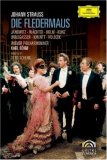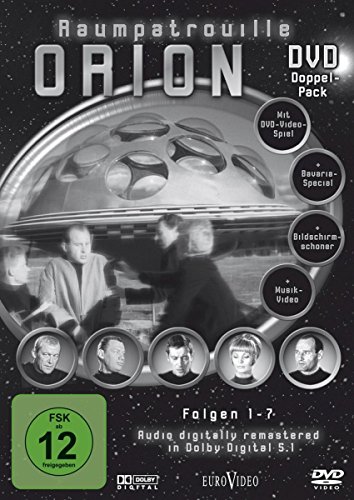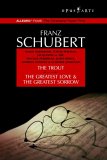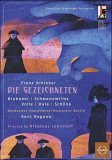 Nosferatu (1922) - Two-disc set | DVD | (22/01/2001)
from £N/A
| Saving you £N/A (N/A%)
| RRP
Nosferatu (1922) - Two-disc set | DVD | (22/01/2001)
from £N/A
| Saving you £N/A (N/A%)
| RRP Nosferatu ... the name alone can chill the blood!". F.W. Murnau's Nosferatu, released in 1922, was the first (albeit unofficial) screen adaptation of Bram Stoker's Dracula. Nearly 80 years on, it remains among the most potent and disturbing horror films ever made. The sight of Max Schreck's hollow-eyed, cadaverous vampire rising creakily from his coffin still has the ability to chill the blood. Nor has the film dated. Murnau's elision of sex and disease lends it a surprisingly contemporary resonance. The director and his screenwriter Henrik Gaalen are true to the source material, but where most subsequent screen Draculas (whether Bela Lugosi, Christopher Lee, Frank Langella or Gary Oldman) were portrayed as cultured and aristocratic, Nosferatu is verminous and evil. (Whenever he appears, rats follow in his wake.)The film's full title--Nosferatu, eine Symphonie des Grauens (Nosferatu, A Symphony of Horror)--reveals something of Murnau's intentions. Supremely stylised, it differs from Robert Wiene's The Cabinet of Dr Caligari (1919) or Ernst Lubitsch's films of the period in that it was not shot entirely in the studio. Murnau went out on location in his native Westphalia. As a counterpoint to the nightmarish world inhabited by Nosferatu, he used imagery of hills, clouds, trees and mountains (it is, after all, sunlight that destroys the vampire). It's not hard to spot the similarity between the gangsters in film noir hugging doorways or creeping up staircases with the image of Schreck's diabolic Nosferatu, bathed in shadow, sidling his way toward a new victim. Heavy chiaroscuro, oblique camera angles and jarring close-ups--the devices that crank up the tension in Val Lewton horror movies and edgy, urban thrillers such as Double Indemnity and The Postman Always Rings Twice--were all to be found first in Murnau's chilling masterpiece. --Geoffrey MacnabOn the DVD: This two-disc set gives you the choice of watching Nosferatu in either a sepia-tinted version or the original black & white. Both, however, feature the same modern electronic music score by Art Zoyd (at the movie's lavish 1922 premiere a live orchestra performed a newly composed, quasi-Wagnerian score by Hans Erdmann). The anonymous commentary track is a scholarly critical appraisal of the movie that exhaustively documents every aspect of it, from Murnau's aesthetic use of framing devices to the homoerotic subtext of the Hutter-Orlock relationship. In the "Nosferatour" featurette the movie's locations (principally, the Baltic cities of Wismer and Lubeck) are shown as they are today, and there is also a look at the original artwork that served as Murnau's inspiration. Two text features provide a brief history of the vampire myth from Vlad the Impaler onwards, as well as a discussion of the controversy caused by the movie's release. Appropriately, a trailer for the John Malkovich-Willem Dafoe movie Shadow of the Vampire, which imagines that "Max Schreck" actually was a vampire employed by Murnau in his obsessive pursuit of verisimilitude, is also included. --Mark Walker
 Johann Strauss - Die Fledermaus - Karl Bohm/Wiener Philharmoniker | DVD | (05/11/2007)
from £15.75
| Saving you £1.24 (7.30%)
| RRP
Johann Strauss - Die Fledermaus - Karl Bohm/Wiener Philharmoniker | DVD | (05/11/2007)
from £15.75
| Saving you £1.24 (7.30%)
| RRP This is Otto Schenk's quintessentially Viennese 1972 production of Strauss's masterpiece Die Fledermaus featuring a Viennese dream cast - Janowitz Wchter Windgassen Bhm and the Vienna Philharmonic. Tracklisting: 1. Overture 2. Nr.1 Introduktion: ""Tubchen das entflattert ist"" 3. ""Das ist er der Alfred!""/Nr. 1a ""Ach ich darf nicht hin zu dir"" 4. ""So ein Pillerl beruhigt enorm"" 5. Nr.2 Terzett: ""Nein mit solchen Advokaten"" 6. ""Also den sind wir los"" 7. Nr.3 Duett: ""Komm mit mir zum Souper"" 8. ""Was ist denn das?"" 9. Nr.4 Terzett: ""So muss allein ich bleiben"" 10. Na der wird sich fabelhaft im Arrest amsieren"" 11. Nr.5 Finale: ""Trinke Liebchen trinke schnell"" 12. ""Da kommt doch jemand?"" 13. ""Mein Herr was dchten Sie von mir"" 14. Mein schnes grosses Vogelhaus 15. Nr.6 Introduktion: ""Ein Souper heut uns winkt"" 16. ""Ida!"" - ""Adele!"" 17. Nr.7 Couplet: ""Ich lade gern mir Gste ein"" 18. ""Nasdrowje!"" 19. Nr.8 Ensemble und Couplet: ""Ach meine Herr'n und Damen"" 20. ""Mein Herr Marquis"" 21. ""Aber meine Herrschaften"" 22. Nr.9 Duett: ""Dieser Anstand so manierlich"" 23. ""Da ist sie ja die schne Unbekannte!"" 24. Nr.10 Csrds: ""Klnge der Heimat"" 25. ""Na bin ich eine echte Ungarin?"" 26. Nr.11 Finale: ""Im Feuerstrom der Reben"" 27. ""Herr Chevalier ich grsse Sie!"" 28. Brderlein und Schwesterlein 29. Polka ""Unter Donner und Blitz"" op.324 30. ""Genug damit genug"" 31. Dialog: Tubchen das entflattert ist 32. Nr. 13 ""Mongolen sagen immer"" 33. ""Was sagen Sie? - ""Sie besoffener Idiot!"" 34. Nr.14 Couplets: ""Spiel' ich die Unschuld vom Lande"" 35. ""Aber selbstverstndlich werd' ich Sie ausbilden lassen!"" 36. Nr.15 Terzett: ""Ich stehe voll Zagen"" 37. ""So du willst dich also rchen"" 38. Nr.16 Finale: ""O Fledermaus o Fledermaus""
 Jerry Maguire / Rain Man / Few Good Men | DVD | (03/10/2005)
from £N/A
| Saving you £N/A (N/A%)
| RRP
Jerry Maguire / Rain Man / Few Good Men | DVD | (03/10/2005)
from £N/A
| Saving you £N/A (N/A%)
| RRP Jerry Maguire (Dir. Barry Levinson 1996): Jerry Maguire (Tom Cruise) is a man who knows the score. As a top agent at Sports Management International Jerry is unquestionably master of his universe - until that is he gets a sudden attack of morals and is unceremoniously fired! Hanging on by a thread Jerry is forced to start from scratch supported only be three very unlikely allies- single mother Dorothy Boyd (Renee Zellweger ) her cheeky young son Ray and Rod Tidwell (Cuba Gooding Jr.) a second rank player for the Arizona Cardinals - and Jerry's sole remaining client. Rain Man (Dir. Cameron Crowe 1988): Dustin Hoffman joins Tom Cruise to bring a funny and moving tale of brotherly love to the screen. Heartless Charlie Babbitt expects a vast inheritance after his estranged father dies. But Raymond his institutionalised older brother someone he's been totally unaware of is willed the entire fortune instead. Raymond is an 'autistic Savant' with severely limited mental abilities in some areas but with genius gifts in others. When Charlie kidnaps Raymond the crazy cross-country drive back to Los Angeles teaches them both a few lessons in life. For as they overcome their mutual distrust of each other a deep bond is forged as they painfully share past memories present problems and a possible shining future together. A Few Good Men (Dir. Rob Reiner 1992): One man is dead. Two men are accused of his murder. The entire Marines Corps is on trial. And 'A Few Good Men' are about to ignite the most explosive episode in US military history. Universally acclaimed A Few Good Men unites the big screen's biggest stars as Hollywood heavyweights Jack Nicholson Tom Cruise and Demi Moore lead an all star cast in director Rob Reiner's powerful account of corruption cover-up and a relentless quest for justice within the sacred corridors of the US Navy. With powerful performances from Kevin Bacon and Kiefer Sutherland A Few Good Men makes its mark as one of the best courtroom dramas of the '90s..
![24 Hours to Kill [DVD]](/pictures/1136118.jpg) 24 Hours to Kill | DVD | (03/08/2015)
from £7.98
| Saving you £4.00 (66.78%)
| RRP
24 Hours to Kill | DVD | (03/08/2015)
from £7.98
| Saving you £4.00 (66.78%)
| RRP Tarzan star Lex Barker and Hollywood legend Mickey Rooney head a glittering international cast in this crime thriller from British B-movie mogul Harry Alan Towers – Barker starring as the pilot of a stricken American airliner and Rooney as the purser whose eye for easy money sees him tangling with a ruthless gang of smugglers. Blending glamour humour and action – and boasting stunning location film of mid-sixties Beirut – 24 Hours to Kill is presented here in a brand-new transfer from the original film elements in its original aspect ratio. When a jet airliner with engine trouble lands in Beirut for a twenty-four hour stopover purser 'Jonesey' fears his life is in danger from a gold-smuggling gang whom he double-crossed on a previous trip. So begins a day of chilling suspense as he and other crew members find themselves embroiled in a desperate race to get out of the country alive! Features: German Theatrical Trailer Image Gallery Original Pressbook PDF
![Wagner: Parsifal [Blu-ray] [2013] [Region Free]](/pictures/1128292.jpg) Wagner: Parsifal | Blu Ray | (29/07/2013)
from £N/A
| Saving you £N/A (N/A%)
| RRP
Wagner: Parsifal | Blu Ray | (29/07/2013)
from £N/A
| Saving you £N/A (N/A%)
| RRP NOTICE: Polish Release, cover may contain Polish text/markings. The disk DOES NOT have English audio and subtitles.
![The Golden Ring [1965]](/pictures/1028508.jpg) The Golden Ring | DVD | (08/07/2002)
from £N/A
| Saving you £N/A (N/A%)
| RRP
The Golden Ring | DVD | (08/07/2002)
from £N/A
| Saving you £N/A (N/A%)
| RRP When The Golden Ring was aired on the BBC in 1965, it was the longest music documentary ever made. And though now Humphrey Burton's 90-minute black and white film about Georg Solti's landmark recording of Gotterdammerung seems rather rough and naïve in its use of basic documentary techniques, the excitement it conveys about the gargantuan Ring cycle project is still palpable. Underlings scuttle about, engineers endlessly fiddle with knobs, and Decca producer John Culshaw oversees the largest recording project ever undertaken with the command of a great military general. The technical insights are fascinating: all the sound mixing has to be done immediately, for instance, and echo effects are created by placing certain instruments in different rooms with closed-circuit TV cameras giving them Solti's beat. Culshaw's legendary attention to detail is also noted: he had obsolete stierhorns made especially for Hagen's call to the Gibichung vassals. Burton's documentary style is a little awkward, and his use of cut-aways and fades now seems antiquated. But he is sensible enough to allow generous portions of the music to speak for themselves, and the closing scene--Birgit Nilsson singing Brunnhilde's immolation--is simply heart-stopping. Despite the roughness, this film undoubtedly still captures one of the greatest moments in the history of classical music recording. On the DVD: The Golden Ring, as you might expect from a 1965 documentary, has patchy sound and picture quality (from a mixture of video and 16mm film). Occasionally the tape seems to splinter a little and the microphones fail to catch certain conversations with clarity. But somehow it all adds to the raw excitement and doesn't detract from the subject matter. The DVD also includes 69 minutes of audio highlights from the final recording.--Warwick Thompson
![Most Wanted [1998]](/pictures/1023284.jpg) Most Wanted | DVD | (01/10/1999)
from £N/A
| Saving you £N/A (N/A%)
| RRP
Most Wanted | DVD | (01/10/1999)
from £N/A
| Saving you £N/A (N/A%)
| RRP Comic actor Keenen Ivory Wayans made a creditable effort to expand his career horizons by writing the script for this action thriller, in which he also stars. Wayans plays US Marine Sgt James Dunn, a military hero who refuses an order to shoot a young shepherd during the Gulf War. His insubordination leads to a lethal struggle with a superior officer and a subsequent murder conviction against Dunn.Plucked from his death sentence by a covert unit of Marines, however, Dunn soon finds himself in a shadowy world of undercover wars under the command of one Lt Col. Grant Casey (Jon Voight). Offered freedom in exchange for aiding a mission against a corrupt industrialist (Robert Culp), Dunn agrees and then discovers he has actually been set up to take the fall for an assassination. Suddenly, he's the most wanted man in the world, with police, the military, the Secret Service and legions of reward seekers chasing him around Los Angeles. Jill Hennessy stars as an eyewitness who happened to catch the killing on videotape and can clear Dunn if she would only cooperate with him--a problem, since he has kidnapped her. Directed by David Glenn Hogan, Most Wanted works just fine as a well-oiled action piece with a capable star and competent action sequences. The story ideas (especially Dunn's Rambo-esque flight through the city and his reliance on esoteric survival skills) feel overly familiar, but that only makes Most Wanted all the more enjoyable as a pot-boiler instead of a serious original. --Tom Keogh
 RAUMPATROUILLE ORION (DVD) - S | DVD | (26/10/1999)
from £N/A
| Saving you £N/A (N/A%)
| RRP
RAUMPATROUILLE ORION (DVD) - S | DVD | (26/10/1999)
from £N/A
| Saving you £N/A (N/A%)
| RRP  Schubert: The Trout / The Greatest Love And The Greatest Sorrow | DVD | (27/06/2005)
from £33.73
| Saving you £-8.74 (-35.00%)
| RRP
Schubert: The Trout / The Greatest Love And The Greatest Sorrow | DVD | (27/06/2005)
from £33.73
| Saving you £-8.74 (-35.00%)
| RRP The Trout is an exuberant explosion of youthful enjoyment in music: first from Schubert himself who wrote his famous Trout quintet when he was 22 years old and then from five young artists of the highest rank. They pick up the spirit of Schubert's music magnificently both in preparation and rehearsal and in their 1969 performance of the work which has become one of the most remembered ever given.The Greatest Love and the Greatest Sorrow is a film which sets out to bring the viewer closer not to the details of Schubert's life but to the spirit of what he was trying to express with what he called his creative gift and with which he tried to brighten the world. The film begins with the funeral of Beethoven at which Schubert was a torch-bearer and the story is told almost entirely in music that Schubert wrote in the twenty months that remained to him after that date together with quotations from his letters and diaries and the words that he chose to set in some of his songs.
![FISTFUL OF DOLLARS (1967) - FISTFUL OF DOLLARS (1967) (1 Blu-ray) [2018]](/pictures/1155396.jpg) FISTFUL OF DOLLARS (1967) - FISTFUL OF DOLLARS (1967) (1 Blu-ray) | Blu Ray | (22/05/2018)
from £N/A
| Saving you £N/A (N/A%)
| RRP
FISTFUL OF DOLLARS (1967) - FISTFUL OF DOLLARS (1967) (1 Blu-ray) | Blu Ray | (22/05/2018)
from £N/A
| Saving you £N/A (N/A%)
| RRP ![The Expert [1995]](/pictures/1003688.jpg) The Expert | DVD | (04/03/2002)
from £N/A
| Saving you £N/A (N/A%)
| RRP
The Expert | DVD | (04/03/2002)
from £N/A
| Saving you £N/A (N/A%)
| RRP John Lomax a special operations expert finds out that his sister has been murdered. In his attempt to discover the perpetrator he helps the police. However when the killer gets a minor sentence Lomax turns vigilante and decides to take justice into his own hands.
 Strauss - Der Zigeunerbaron | DVD | (12/05/2008)
from £N/A
| Saving you £N/A (N/A%)
| RRP
Strauss - Der Zigeunerbaron | DVD | (12/05/2008)
from £N/A
| Saving you £N/A (N/A%)
| RRP Johann Strauss - Der Zigeunerbaron.
![Sherlock Holmes And The Deadly Necklace [1962]](/pictures/1011963.jpg) Sherlock Holmes And The Deadly Necklace | DVD | (25/09/2006)
from £8.08
| Saving you £-2.09 (N/A%)
| RRP
Sherlock Holmes And The Deadly Necklace | DVD | (25/09/2006)
from £8.08
| Saving you £-2.09 (N/A%)
| RRP Holmes and Watson are on the trail to find a necklace that once belonged to Cleopatra. Holmes must unravel the mystery which brings him face to face with his arch rival Moriarty...
![The Vengeance Of Fu Manchu [1967]](/pictures/1002103.jpg) The Vengeance Of Fu Manchu | DVD | (27/10/2003)
from £N/A
| Saving you £N/A (N/A%)
| RRP
The Vengeance Of Fu Manchu | DVD | (27/10/2003)
from £N/A
| Saving you £N/A (N/A%)
| RRP In his remote Asian hideaway the evil Fu Manchu plots the death and discredit of his arch rival Inspector Nayland Smith of Scotland Yard as the first step in his plan to become leader of the world's most terrible criminals...
![Der Freischutz [1981]](/pictures/1028141.jpg) Der Freischutz | DVD | (05/07/2004)
from £16.18
| Saving you £1.81 (11.19%)
| RRP
Der Freischutz | DVD | (05/07/2004)
from £16.18
| Saving you £1.81 (11.19%)
| RRP In this production by the German artist Achim Freyer Weber's classic German opera is set in the style of a 19th century fairy tale but with the events in the plot seen through 20th century eyes. A blend of rustic humour a dash of the supernatural and the eventual triumph of good over evil Der Freioschutz has becomea much-loved work with international opera audiences.
![Woyzeck [1978]](/pictures/1006033.jpg) Woyzeck | DVD | (02/09/2002)
from £N/A
| Saving you £N/A (N/A%)
| RRP
Woyzeck | DVD | (02/09/2002)
from £N/A
| Saving you £N/A (N/A%)
| RRP In Werner Herzog's brilliant adaptation of Georg Buchner's 'Woyzeck' Klaus Kinski delivers a wild and stunning performance in a role only he could play. Franz Woyzeck (Kinski) is a hapless solider alone and powerless in society assaulted from all sides by forces he cannot control. Abused and tortured both physically and psychologically by commanding officers doctors and his unfaithful wife Marie (Eva Mattes Best Supporting Actress at Cannes) Woyzeck struggles to hold on to his
![Nosferatu [1922]](/pictures/1013008.jpg) Nosferatu | DVD | (16/11/2009)
from £N/A
| Saving you £N/A (N/A%)
| RRP
Nosferatu | DVD | (16/11/2009)
from £N/A
| Saving you £N/A (N/A%)
| RRP Nosferatu ... the name alone can chill the blood!". F.W. Murnau's Nosferatu, released in 1922, was the first (albeit unofficial) screen adaptation of Bram Stoker's Dracula. Nearly 80 years on, it remains among the most potent and disturbing horror films ever made. The sight of Max Schreck's hollow-eyed, cadaverous vampire rising creakily from his coffin still has the ability to chill the blood. Nor has the film dated. Murnau's elision of sex and disease lends it a surprisingly contemporary resonance. The director and his screenwriter Henrik Gaalen are true to the source material, but where most subsequent screen Draculas (whether Bela Lugosi, Christopher Lee, Frank Langella or Gary Oldman) were portrayed as cultured and aristocratic, Nosferatu is verminous and evil. (Whenever he appears, rats follow in his wake.)The film's full title--Nosferatu, eine Symphonie des Grauens (Nosferatu, A Symphony of Horror)--reveals something of Murnau's intentions. Supremely stylised, it differs from Robert Wiene's The Cabinet of Dr Caligari (1919) or Ernst Lubitsch's films of the period in that it was not shot entirely in the studio. Murnau went out on location in his native Westphalia. As a counterpoint to the nightmarish world inhabited by Nosferatu, he used imagery of hills, clouds, trees and mountains (it is, after all, sunlight that destroys the vampire). It's not hard to spot the similarity between the gangsters in film noir hugging doorways or creeping up staircases with the image of Schreck's diabolic Nosferatu, bathed in shadow, sidling his way toward a new victim. Heavy chiaroscuro, oblique camera angles and jarring close-ups--the devices that crank up the tension in Val Lewton horror movies and edgy, urban thrillers such as Double Indemnity and The Postman Always Rings Twice--were all to be found first in Murnau's chilling masterpiece. --Geoffrey Macnab
![Funny Games [1998]](/pictures/1023062.jpg) Funny Games | DVD | (19/02/2001)
from £N/A
| Saving you £N/A (N/A%)
| RRP
Funny Games | DVD | (19/02/2001)
from £N/A
| Saving you £N/A (N/A%)
| RRP A family settles into their new vacation home, which just so happens to be the next stop for a pair of young, articulate, white-gloved serial killers on an excursion through the neighborhood.
 Die Gezeichneten - Schreker | DVD | (03/07/2006)
from £26.98
| Saving you £-1.99 (-8.00%)
| RRP
Die Gezeichneten - Schreker | DVD | (03/07/2006)
from £26.98
| Saving you £-1.99 (-8.00%)
| RRP Franz Schreker's Die Gezeichneten a performance from the Salzburger Festspiele recorded live at the Felsenreitschule 26 July 2005.
![FreeStyle [DVD]](/pictures/1098536.jpg) FreeStyle | DVD | (01/03/2010)
from £6.39
| Saving you £6.60 (103.29%)
| RRP
FreeStyle | DVD | (01/03/2010)
from £6.39
| Saving you £6.60 (103.29%)
| RRP Two friends will help eachother overcome prejudice from their peers by letting it all out on the basketball courts with their passion and talent to FREESTYLE.

Please wait. Loading...
This site uses cookies.
More details in our privacy policy